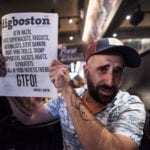Images via Arcadia
Dr. Regina Marchi is an associate professor of journalism and media studies at Rutgers, all the way in New Jersey. She doesn’t have much of a New England accent. But don’t get confused; she’s an East Bostonian to the core, as well as one of the few authors to ever dedicate a volume to her home turf.
Throwback buffs that we are at DigBoston, we enthusiastically thumbed through Marchi’s brand new Legendary Locals of East Boston and reached out for an interview. Community soul that the author is, she welcomed our request with the kindness of a traditional Italian family inviting friends over for Sunday dinner and explained, among other things, how she went from writing term papers at Boston Latin School about her native stomping ground to publishing an entire book on the topic.
Tell me about your early years. What was your childhood like in Eastie?
In those days, there were tons of kids who played outside on the streets … there were literally hundreds of kids riding their bikes, playing dodgeball, manhunt, stickball … One of my most fun memories is how when somebody would throw away a large box from a refrigerator or television, we would take the box, flatten it out, and go to East Boston High to slide down the hill. That was the most fun you could possibly have besides running through the hydrants.
Did  you feel like you grew up in part of a bigger Boston, or in your own city entirely?
you feel like you grew up in part of a bigger Boston, or in your own city entirely?
East Boston is originally geographically an island, and even today there is an island mentality for people who were born and grew up there. You need to mentally and physically make the journey to downtown, over the bridge or through the tunnel, and a lot of people in East Boston really don’t leave the neighborhood. Growing up, we didn’t leave that often, and when we did it was sort of a big thing … When I got a little older, when I was 12 and started going to Boston Latin School, I was taking the subway with my brother and my other friends. We were the small Eastie contingent, and from that point on I went in almost every weekday.
Is there any particular part of the city that you and your family are tied to?
I grew up in Eagle Hill, and own a house there, and that’s where there’s a concentration of the older homes, the Victorian-style houses. Sometimes you can’t tell, because they’re covered with vinyl siding, but if you take that down there are some really very beautiful homes. Governor Bates had his mansion there, and that’s mentioned in my book, and the famous shipbuilder Donald McKay had his mansion there too, and that’s the house where my best friend from elementary school’s grandmother lived, so we used to play in that house as kids. At the time, I knew that it was a famous shipbuilder’s house, but looking back I can’t believe I used to eat dinner in that dining room.
What is it about Eastie that has made it such a great place for immigrant communities to rally?
The first settlers were White Anglo-Saxon Protestants, but by the 1880s you had a lot of Irish immigrants, followed by a lot more Jewish and Italian into the 1900s, and in the 1980s, a lot of Latinos, and also of course Southeast Asian. I think East Boston has historically been attractive to immigrants for a couple of major reasons. It’s close enough to the city that you can work downtown and be there in five minutes. Early on, a lot of Italian immigrants [were] working and sewing at the fancy wedding gown companies, or the men [were] working on building the original subways and tunnels. Today, so many of the Latino and other immigrant populations are working in the city, whether that’s as a chef, or a waiter, or other service industry jobs. The key about East Boston is that because it’s not Downtown Boston, the rent has historically been cheaper.
You lived this, but what made you say, “It’s time to write a book about Eastie”?
I’ve always wanted to write a book about East Boston. I felt that of all the Boston neighborhoods, East Boston really gets kind of short shrift. There is a book written by Anthony Sammarco, and it’s also by Arcadia, which is publishing my book. His book focuses more on the history of particular buildings and streets, much more physical localities in Boston, whereas I tell the history through East Boston residents, the personal stories of individuals who grew up here … I really wanted to write this because growing up, I was always really shocked how many people from outside of East Boston had never been to East Boston, or even heard of it. For too long, people have thought that it was just an airport.
LEGENDARY LOCALS OF EAST BOSTON READING AND BOOK SIGNING WITH DR. REGINA MARCHI. WED 7.22. ZUMIX, 260 SUMNER ST., EAST BOSTON. 7:30PM/ALL AGES/FREE.
A Queens, NY native who came to New England in 2004 to earn his MA in journalism at Boston University, Chris Faraone is the editor and co-publisher of DigBoston and a co-founder of the Boston Institute for Nonprofit Journalism. He has published several books including 99 Nights with the 99 Percent, and has written liner notes for hip-hop gods including Cypress Hill, Pete Rock, Nas, and various members of the Wu-Tang Clan.


